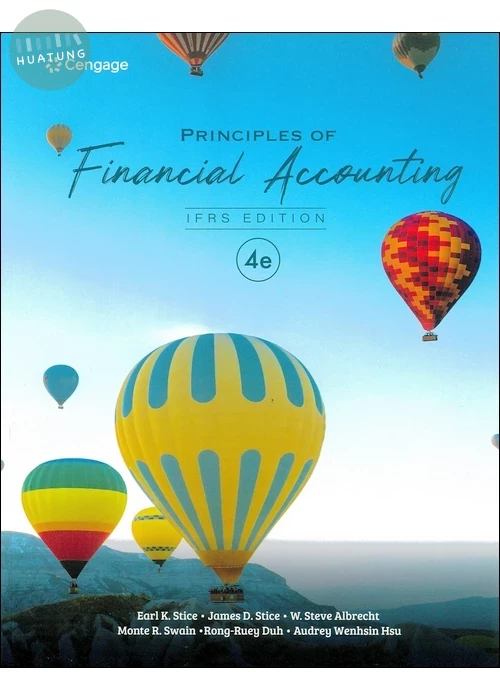
| 定價: | ||||
| 售價: | 1800元 | |||
| 庫存: | 已售完 | |||
| LINE US! | ||||
| 此書為本公司代理,目前已售完,有需要可以向line客服詢問進口動向 | ||||
| 付款方式: | 超商取貨付款 |

|
|
| 信用卡 |

|
||
| 線上轉帳 |

|
||
| 物流方式: | 超商取貨 | ||
| 宅配 | |||
| 門市自取 |
為您推薦

類似書籍推薦給您
書名:Financial Accounting Theory 8/E 作者:Scott 出版社:PEARSON 出版日期:2020/01/00 ISBN:9780134166681 內容簡介 • Theory in Practice: These vignettes provide real-world cases that illustrate the theoretical concepts. Some are pursued further in end-of-chapter Questions and Problems. • Examples: Numerical examples with detailed commentary about the method of solution make the theory more concrete, reinforcing students' learning. • Figures: Each chapter begins with a schematic figure. The figure at the start of Chapter 1 shows the design of the book, and each subsequent chapter starts with a figure showing the design of that chapter. • Questions and Problems: Each chapter except Chapter 1 ends with questions and problems that allow students to test, and sometime extend, their understanding of the chapter's contents. 目錄 1 Introduction 2 Accounting Under Ideal Conditions 3 The Decision-usefulness Approach to Financial Reporting 4 Efficient Securities Markets 5 The Value Relevance of Accounting Information 6 The Valuation Approach to Decision Usefulness 7 Valuation Applications 8 Efficient Contracting Theory and Accounting 9 An Analysis of Conflict 10 Executive Compensation 11 Earnings Management 12 Standard Setting: Economic Issues 13 Standard Setting: Political Issues

類似書籍推薦給您

類似書籍推薦給您
【簡介】 【目錄】 Table of Contents PART I: FINANCIAL REPORTING AND THE ACCOUNTING CYCLE 1. Accounting Information: Users and Uses 2. Financial Statements: An Overview 3. The Accounting Cycle: The Mechanics of Accounting 4. Completing the Accounting Cycle 5. Internal Controls: Ensuring the Integrity of Financial Information PART II: OPERATING ACTIVITIES 6. Cash 7. Receivables 8. Inventory and the Cost of Sales 9. Completing the Operating Cycle PART III: INVESTING AND FINANCING ACTIVITIES 10. Investments: Property, Plant, and Equipment and Intangible Assets 11. Financing: Long-Term Liabilities 12. Financing: Equity 13. Investments: Debt and Equity Securities PART IV: OTHER DIMENSIONS OF FINANCIAL REPORTING 14. Statement of Cash Flows 15. Analyzing Financial Statements Appendices Appendix A: Taiwan Semiconductor Manufacturing Company Limited and Subsidiaries Consolidated Financial Statements for the Years Ended December 31, 2023 and 2022 and Independent Auditors’ Report Appendix B: Philips 2023 Financial Statements Appendix C: Carrefour 2023 Financial Statements Appendix D: Present Value Tables Glossary Index

類似書籍推薦給您
【簡介】 【目錄】 Table of Contents PART I: FINANCIAL REPORTING AND THE ACCOUNTING CYCLE 1. Accounting Information: Users and Uses 2. Financial Statements: An Overview 3. The Accounting Cycle: The Mechanics of Accounting 4. Completing the Accounting Cycle 5. Internal Controls and Cash PART II: OPERATING ACTIVITIES 6. Receivables 7. Inventory and the Cost of Sales 8. Completing the Operating Cycle PART III: INVESTING AND FINANCING ACTIVITIES 9. Investments: Property, Plant, and Equipment and Intangible Assets 10. Financing: Long-Term Liabilities 11. Financing: Equity 12. Investments: Debt and Equity Securities PART IV: OTHER DIMENSIONS OF FINANCIAL REPORTING 13. Statement of Cash Flows 14. Analyzing Financial Statements Appendices Appendix A : Taiwan Semiconductor Manufacturing Company Limited and Subsidiaries Consolidated Financial Statements for the Years Ended December 31, 2015 and 2014 and Independent Auditors’Report Appendix B : Philips 2015 Financial Statements Appendix C : Carrefour 2015 Financial Statements Appendix D : Present Value Tables Glossary Index

類似書籍推薦給您
【簡介】 Fundamentals of Financial Accounting introduces students to financial accounting using a balanced mix of conversational wording, clear and concise presentations, and everyday examples, allowing students to grasp concepts fundamental to financial accounting without sacrificing rigor or coverage. It incorporates carefully chosen focus companies that students recognize and engage within their everyday lives. From tech start-ups to some of the world's most familiar trademark brands, each chapter opens with an engaging scenario or story using a familiar company. The same focus company is used throughout the entire chapter so that students can see how the concepts and calculations apply to a real-world company they are already familiar with. Fundamentals of Financial Accounting uses peer-reviewed research and careful analysis of data to inform pedagogy and presentation of concepts. For example, the authors research on various approaches to teaching the accounting cycle informed the step-by-step model used in the text -- a model proven to lead to better results in short-term assessment as well as in long-term understanding and application of the material. By breaking the accounting cycle down into more cohesive, bite-sized segments, students develop a stronger foundational understanding. 【目錄】 Ch 1 Business Decisions and Financial Accounting Ch 2 The Balance Sheet Ch 3 The Income Statement Ch 4 Adjustments, Financial Statements, and Financial Results Ch 5 Fraud, Internal Control, and Cash Ch 6 Merchandising Operations and the Multistep Income Statement Ch 7 Inventory and Cost of Goods Sold Ch 8 Receivables, Bad Debt Expense, and Interest Revenue Ch 9 Long-Lived Tangible and Intangible Assets Ch10 Liabilities Ch11 Stockholders’ Equity Ch12 Statement of Cash Flows Ch13 Measuring and Evaluating Financial Performance APPENDIX A: Excerpts from the Fiscal 2021 10-K Annual Report of The Home Depot, Inc. APPENDIX B: Excerpts from the Fiscal 2021 10-K Annual Report of Lowe’s Companies, Inc. APPENDIX C: Present and Future Value Concepts APPENDIX D: (Available in Connect) Investments in Other Corporations